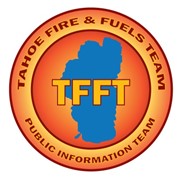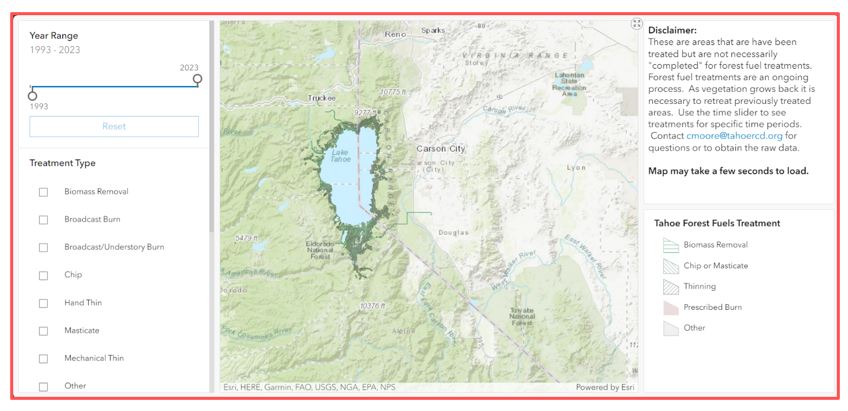Forest restoration and fuels reduction treatment map highlights Tahoe Fire & Fuels Team accomplishments

Contact: Tahoe Resource Conservation District, Cara Moore
LAKE TAHOE, Calif./Nev., July 15, 2024 - In collaboration with the Tahoe Fire & Fuels Team (TFFT), the Tahoe Resource Conservation District (TRCD) is pleased to announce the Forest Vegetation Interactive Map that highlights forest restoration and fuels reduction treatment accomplishments of the TFFT and the Lake Tahoe Environmental Improvement Program (EIP). The EIP is a landscape-scale collaborative partnership between nearly 80 public and private organizations working to achieve environmental goals across the region and includes local, state, and federal government agencies, private entities, scientists, and the Washoe Tribe of Nevada and California.
The Forest Vegetation Treatment Interactive Map is a user-friendly, interactive tool available to the public that converts vegetation treatment data into interactive maps. Map layers include data for treatments including biomass removal, chipping and masticating, forest thinning and prescribed fire.
Vegetation treatments help achieve the EIP/TFFT’s goals of creating healthy, resilient forests with desired vegetation conditions. Since 1997, TFFT partners have treated more than 94,000 acres in the Tahoe Basin.
These vegetation treatments take place in general forest areas, Community Defense Zones, Threat Zones and on publicly owned urban parcels. Treatment Zones and Treatment Types are defined on the EIP Program Performance Measure webpage.
Treatments are shown over time (1993-2023) and users can interactively adjust the time scale to view past treatments for any time range desired. The map also shows wildfires that have burned during the same period. If users are interested in where current or future projects are being implemented, that data is also available to view.
Forest restoration and fuels reduction treatments have been largely prioritized in forest areas in and around Tahoe Basin communities but are also being expanded to other forest areas further out where risk of wildfires could threaten communities, wildlife habitat and recreation resources.
Vegetation treatments are reported at the end of the year in which they are completed. In many cases, more than one type of treatment is needed to fully accomplish hazardous fuels reduction prescriptions. For example, forest thinning by hand crews and piling of cut material is completed and shown as accomplished in 2020, then burning of the slash piles is completed and shown accomplished in 2024.
Forest restoration and fuels reduction projects are a vital forest management tool used by land managers to help protect communities by removing excess vegetation (fuels) on public lands that can feed unwanted wildfires. These projects complement defensible space and home hardening efforts on private property in neighborhoods and communities.
Forest restoration and fuels reduction projects also contribute to forest health by thinning trees in areas where densities are high, which reduces competition for water, sunlight and nutrients allowing remaining trees to grow larger. Thinning also decreases the potential for spreading diseases and insect infestation such as white pine blister rust, dwarf mistletoe and bark beetles.
Short-term impacts from forest restoration and fuels reduction projects include temporary disturbances to recreational areas and changes to the appearance of basin forests. Treated areas may look disturbed immediately after treatment, where fresh stumps, equipment tracks and freshly chipped or masticated vegetation, or burned materials are more visually obvious, but they recover quickly as winter weather, sun-bleaching and new vegetation growth takes place within a few years. Similar short term visual impacts can occur after prescribed fire treatments, but they also recover quickly like thinning treatments.
Projects usually take place in the summer and continue into fall as conditions and weather allow. However, some operations may be implemented over the snow when conditions permit.
Prior to European settlement, wildfires and indigenous burning in the West helped maintain forest health and fuels conditions in Sierra Nevada forests. For most of the Tahoe Basin, fires burned across the landscape every 5-35 years. As time passes after treatments are implemented, trees continue to grow, new trees sprout, shrubs and other ground vegetation matures, and hazardous fuels continue to accumulate making fuels treatments an ongoing process. As the vegetation grows back it is necessary to retreat previously treated areas.
For questions or to obtain the raw data, contact TRCD’s Cara Moore at
###
